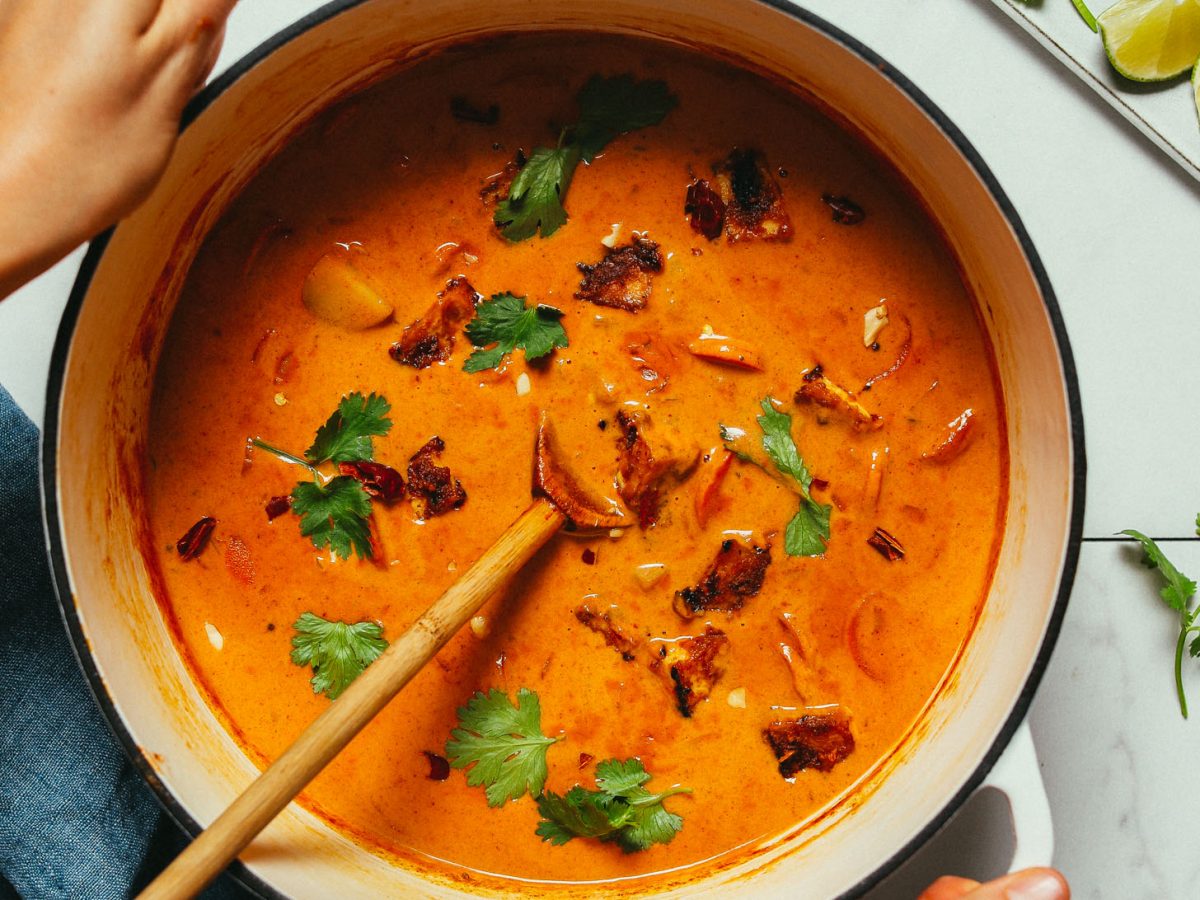RE-ENVISION: Massaman curry
RE-ENVISION is an ongoing series of research memos produced by our associates at Appetite. We trace the cultural genealogies of food from around the world to challenge commonly held beliefs about origin and authenticity.
Massaman curry is one of Thailand’s most iconic dishes. It is a rich, tangy and coconut-based curry traditionally spiced with cardamom, cinnamon, cloves, star anise, cumin, bay leaves, nutmeg, chilli peppers and mace.
Similar to much of modern Thai cuisine, massaman curry is heavily influenced by foreign cultures. The dish draws primarily from Persian Muslim culture of the 17th century, and hence is traditionally paired with chicken, beef, lamb, mutton, or goat. Even the name “massaman” is not native to Thailand; records in the mid-19th century refer to the dish as “mussulman curry”, and mussulman is the archaic term for Muslim.
There are two recurring theories about the curry’s origins. First, that Massaman was introduced to Thailand by Muslim Persian traders in the 17th century. Second, that the dish was created in Siam’s Muslim communities during the Ayutthaya period (13th to 18th century) or as late as the Thonburi era (mid-18th century). The second theory is supported by Thai food expert and internationally-acclaimed chef David Thompson. Regardless, massaman curry finds its origins in Persian Muslim food traditions.
It is important to note that the Ayutthaya Kingdom was a popular trading port that welcomed foreign traders from various countries. In the mid-17th century, Prince Narai, supported by the Persians, usurped the throne from his uncle and was crowned king of Ayutthaya. After his coronation, he granted Shiite Persian Muslims residence within the city walls of Ayutthaya, traditionally only reserved for close allies and Thais. The interaction between the Siamese elite and Persian Muslims led to an organic exchange of culinary recipes and ingredients. According to David Thompson, massaman curry was created in the court of Ayutthaya by a Persian merchant named Sheik Ahmad Qomi in the 17th century.
Upon further investigation, we discovered that most of the spices used in the massaman curry were not native to Thailand either. Cloves, nutmeg, mace and cardamom are from Indonesia; cinnamon from India; star anise from Vietnam and China; bay leaves from Turkey; cumin from Syria; and chili peppers from the Americas. Since the spice trade was dominated by Muslim sailors, they most likely brought the spices during their arrival in Thailand as early as the 9th century. We lack specific dates because most documented records were destroyed during the Burmese-Siamese War of the 18th century.
A dish like massaman curry that draws on influences from around the world has analogues globally. We found the mole sauce in Mexico made with similar spices— chili peppers, cloves, cumin— and paired with the same protein— chicken. Closer to home, we identified the rendang of the Indonesian Minangkabau ethnic group from the 15th century. Massaman curry is not just a result of Thai ingenuity but also the product of centuries of international cultural exchange and commerce.
Annotated Bibliography
Omar Farouk Shaeik Ahmad. n.d. Muslims in the Kingdom of Ayutthaya. http://journalarticle.ukm.my/514/1/1.pdf.
This piece by Omar Farouk Shaeik Ahmad describes the Muslim influences during the Kingdom of Ayutthaya. It focuses on the kingdom’s openness to foreign trade and how cultural exchange occurred during the Ayutthaya period between Muslims and Siam.
Hanuman, Thaan Khun, and Thapakorn Lertviriyavit. 2016. “Massaman Curry – The Untold Story Thaifoodmaster (blog). August 29, 2016.
The author wrote an in depth piece about the possible theories of how Massaman Curry could have been created. They also researche deeply into the Persian Muslim influence on the Ayutthaya kingdom. The piece also highlights the different spices used in the traditional recipe for Massaman Curry.
Thompson, David. 2002. Thai Food: Arharn Thai. Berkeley, Calif: Ten Speed Press.
In his cookbook, David Thompson points out the ties between Sheik Ahmad Qomi and the creation of the dish. He also talks about the influences of Massaman curry and his theory as to how the dish was created.
Robinson, Simon. 2007. “Chili Peppers: Global Warming.” TIME, June 14, 2007.
The TIME article outlines how Chili Peppers reached parts of asia and became staples in regional cuisines. It also describes how Chili Peppers was traded and traveled from the Americas to find home in Asia.
Altbach, Philip G., and Edith S. Hoshino, eds. 1995. International Book Publishing: An Encyclopedia. Garland Reference Library of the Humanities, vol. 1562. New York: Garland Pub.
In the section on the Burmese-Siamese War of 1765-67, the encyclopedia describes the Burmese’s destruction of most of the printed historical records. This source outlines the difficulty in narrowing and finding particular sources about Thai (Siamese) culture.
Written by Nicholas Koh.
Notes
1 Hanuman, Thaan Khun, and Thapakorn Lertviriyavit. 2016. “Massaman Curry – The Untold Story.” Thaifoodmaster (blog). August 29, 2016.
2 Dictionary.com, Definition of Mussulman. Link: https://www.dictionary.com/browse/mussulman
3 Hanuman, Thaan Khun, and Thapakorn Lertviriyavit. 2016. “Massaman Curry – The Untold Story.” Thaifoodmaster (blog). August 29, 2016.
4 Thompson, David. 2002. Thai Food =: Arharn Thai. Berkeley, Calif: Ten Speed Press.
5 Omar Farouk Shaeik Ahmad. n.d. Muslims in the Kingdom of Ayutthaya. Link: http://journalarticle.ukm.my/514/1/1.pdf.
6 Thompson, David. 2002. Thai Food =: Arharn Thai. Berkeley, Calif: Ten Speed Press.
7Aphornsuvan, Thanet. 2003. “History and Politics of the Muslims in Thailand.” Thammasat University. https://seap.einaudi.cornell.edu/sites/seap/files/MuslimThailand.pdf.
8 Robinson, Simon. 2007. “Chili Peppers: Global Warming.” TIME, June 14, 2007. http://content.time.com/time/specials/2007/article/0,28804,1628191_1626317_1632291-1,00.html.
9 Altbach, Philip G., and Edith S. Hoshino, eds. 1995. International Book Publishing: An Encyclopedia. Garland Reference Library of the Humanities, vol. 1562. New York: Garland Pub.
10 Mexconnect, Karen Hursh Graber. Link: https://www.mexconnect.com/articles/2122-demystifying-mole-m%c3%a9xico-s-national-dish
11 Unilever Food Solutions, The history of Archipelago cuisines: Celebrating centuries of taste. Link:https://www.unileverfoodsolutions.co.id/en/chef-inspiration/all-about-indonesian-restaurant/the-history-of-archipelago-cuisines-celebrating-centuries-of-taste.html

